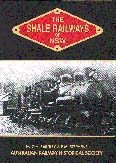The Shale Railways of New South Wales
By G.H. Eardley and E.M. Stephens
Published by Australian Railway Historical Society, New South Wales Division, Sydney, NSW
20cm x 28cm. 224 pages, hard cover, 226 black & white photographs, 24 maps, 6 rolling stock diagrams, addendum.and index.
 The ARHS NSW Division to be congratulated for the re-issue of this classic work, first published in 1974. The entire book has not only been completely retype set by computer, with maps similarly redrawn, but is now printed on gloss art paper.
The ARHS NSW Division to be congratulated for the re-issue of this classic work, first published in 1974. The entire book has not only been completely retype set by computer, with maps similarly redrawn, but is now printed on gloss art paper.
The quality of reproduction of the photographs is greatly improved and their number has been considerably increased, several showing rare historic views of locomotives that were not available in 1974.
Quite rightly, the publisher has decided not to up-date the text as it "was largely written by Giffard Eardley in his own unique style". Those of us old and lucky enough to have known Giff will certainly approve. True, his inimitable style tended to more words as hard facts became fewer, but we all owe him an enormous debt of gratitude for his life-long researches, generosity and encouragement to others and for committing so much to the printed page. The amount of detail in the information and maps is formidable, with the added interest of descriptions of the sites as visited by enthusiasts from the 1930s to the 1950s.
Where up-dating of the text is required, the addendum provides new information on each location as is necessary and a "photo gallery" has been introduced showing yet more new views. So this book is still good value for those who have the original and a must for those that do not.
Most of the shale railways and their attendant mining and processing works occured in truly spectacular mountainous scenery, which added to the interest and difficulty of their operations. All suffered various changes of ownership, far too numerous to list here. However, the main players were the Australian Kerosene & Mineral Co., NSW Shale & Oil Co. Ltd., Commonwealth Oil Corporation Ltd., John Fell & Co. Ltd. and the British-Australian Oil Co. Ltd. The railway systems (all of which had attendant narrow gauge skipways, cable or horse worked) were as follows:
Mount Kembla
1865-1878 Non-locomotive lines only.
Hartley Vale
1878-c1930
Dübs and Morts Dock locomotives, on the unusual one-metre gauge.
Joadja
1878-1908
Four Andrew Barclay 3 ft 6 in gauge locomotives.
Katoomba
1879-1933
Non locomotive lines only. Part of the haulage line still operates as the "Scenic Railway".
Airly
c1883-1897
Non-locomotive lines only.
Torbane
1883-1918
Two locomotives, originally NSWGR 69x and 360x.
Newnes (Wolgan Valley Rly.)
1907-1932
Four standard gauge 'class C' 3-truck Shay locomotives plus a Kerr Stuart tank engine.
Murrurundi
1885-c1914
One locomotive, originally NSWGR 353x.
The two major lines were those owned (initially) by the AKOM Co. at Joadja and the COC Ltd at Newnes. The former was operated in two sections: the lines serving the mines and retorts deep in the Joadja Valley and that from the top of the 1 in 2 incline out of the valley, a gently undulating line of some 9 miles (based on the map; a contemporary account quotes 16 miles) to the Mittagong interchange with the NSWGR. En route it met and crossed the private standard gauge line to the Box Vale Colliery.
The latter operation, at Newnes, (the subject of at least two other substantial books) was perhaps the most spectacular of all the railway lines in Australia, including the NSWGR's Lithgow Zig Zag. Its winding course of 32 miles, with a maximum gradient of 1 in 22.5, included two tunnels and sections that were literally a ledge carved in the mountainside, overhung by vertical cliffs. A passenger service with two imported carriages was operated from a "proper" station provided at Newnes to Newnes Junction on the NSWGR's Great Western Railway.
The rolling stock details for the Wolgan Valley Rly, in the addendum, should also show that the two carriages were built at the Metropolitan Amalgamated Railway Carriage & Wagon Co's Lancaster Works in 1908, order Nos 8400 (the composite 1st/2nd car) and 8401 (the 2nd class car). The reference to the English 4 wheel petrol railcar of 1911 carrying, at least latterly, an Allday & Onions plate, but querying if this came from some machinery within the Newnes Works, surely indicates that the railcar was built by this Birmingham firm. At this period they were the builders of such railcars, including that built in 1908 for the 2ft, gauge Goondah - Burrinjuck Light Railway.
The transference of the book to computer production has had a down-side in that a number of typographical errors have been introduced and the photograph on page 59 of the entrance to the old coal mine at Katoomba is now upside down.
The drawings in the addendum, on page 191, of the Andrew Barclay locomotives at Joadja, attributed to this reviewer, are a travesty. The computer "re-drawing" has rendered them crude of detail and inaccurate in terms of proportions and scaled dimensions. The correction in Light Railways that the driving wheels of Andrew Barclay 237 were only 2 ft 6 in diameter, not 3 ft 0-1/2 in as shown (and very apparent in the photograph of the locomotive on page 49, not included in the original book) has been overlooked.
These are but minor points and the book is highly recommended.
Richard Horne, Light Railways, No.158, April 2001

